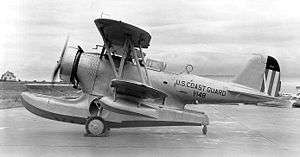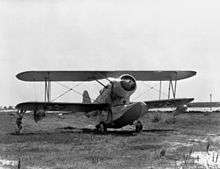Grumman JF Duck
| JF Duck | |
|---|---|
 | |
| Grumman JF-2 Duck in United States Coast Guard service | |
| Role | Utility amphibian |
| National origin | United States |
| Manufacturer | Grumman |
| First flight | 24 April 1933 |
| Introduction | 1935 |
| Primary users | United States Navy United States Marine Corps Argentine Navy United States Coast Guard |
| Number built | 48 |
| Variants | Grumman J2F Duck |
The Grumman JF "Duck" was an American single-engine amphibious biplane built by Grumman for the United States Navy during the 1930s. The J2F Duck was an improved version of the JF, with its main difference being a longer float.[1]
Design and development
The Grumman JF Duck was manufactured from 1934 until 1936, when production switched to the J2F Duck and later variants.[2] The more obvious external appearance clue to distinguish a JF from an early J2F is the deletion of the inter-aileron strut between the wings on the J2F; less noticeable perhaps is the J2F's slightly longer rear fuselage/float joining fillet beneath the tail.[2]
The Duck's main pontoon was part of the fuselage, almost making it a flying boat, though it appears more like a standard aircraft with an added float. This general configuration was shared with the earlier Loening OL. The XJF-1 prototype first flew on 24 April 1933 piloted by Grumman test pilot Paul Hovgard.
Operational history
The JF-1 that was first ordered, had the same Pratt & Whitney R-1830-62 engine as the XJF-1 prototype. The US Navy ordered 27 JF-1s with the first Ducks delivered beginning in May 1934 to Norfolk NAS. These early production series had provisions for mounting a machine gun at the rear seat facing aft, a single bomb rack mounted under each wing, capable of carrying a 100 lb (45.4 kg) bomb or depth charge on each. The main float was also a Grumman design (Grumman Model "A") and like the prototype, it included retractable main landing gear, making the Duck a true amphibian. Ducks served as general/utility amphibians for photographic, target-towing, scouting and rescue work.
Variants
- XJF-1
- Prototype with 700 hp Pratt & Whitney R-1535-62 engine, one built (BuNo 9218).

- JF-1
- Production variant with 700 hp Pratt & Whitney R-1830-62 Twin Wasp engine, 27 built (BuNos 9434-9455, 9523-9527).
- JF-2
- Variant for the United States Coast Guard powered by a 750 hp Wright R-1820-102 Cyclone engine, 15 built (BuNo 0266, 00371-00372, 01647, USCG V141-V155).
- JF-3
- JF-2 for the U.S. Navy, five built (BuNos 9835-9839).
- Grumman G-20
- Armed version of the Grumman JF-2 for export to Argentina. Eight built.[3]
Operators
- Argentine Navy - Operated eight G-20s.[4]
- United States Navy
- United States Coast Guard
- United States Marine Corps - Operated one JF-2
Specifications (JF)
Data from [5]
General characteristics
- Crew: 3
- Capacity: 851 lb (386 kg) payload
- Length: 32 ft 7 in (9.93 m)
- JF-1 & JF-3: 33 ft (10 m)
- Wingspan: 39 ft 0 in (11.89 m)
- Height: 15 ft 1 in (4.60 m)
- Powerplant: 1 × Pratt & Whitney R-1830 Twin Wasp 14-cyl two row air-cooled radial piston engine, 700 hp (520 kW)
- JF-1: 1 x 700 hp (522 kW) Pratt & Whitney R-1830-62
- JF-2: 1 x 720 hp (537 kW) Pratt & Whitney R-1830-102
- JF-3: 1 x 750 hp (559 kW) Pratt & Whitney R-1830-80
Performance
See also
- Related development
- Aircraft of comparable role, configuration and era
References
Notes
- ↑ Allen 1983, p. 49.
- 1 2 Jordan, Corey C. "Grumman's Ascendency: Chapter Two." Planes and Pilots Of World War Two, 2000. Retrieved: 22 July 2011.
- ↑ Allen Air Enthusiast Twenty-three, p.78.
- ↑ Allen Air Enthusiast Twenty-three, pp. 47–48.
- ↑ Eckland, K.O. "Grumman Aircraft: JF Duck." Aerofiles.com, 11 August 2008. Retrieved: 7 May 2012.
Bibliography
- Allen, Francis J. "A Duck Without Feathers". Air Enthusiast, Issue 23, December 1983—March 1984, pp. 46–55, 77—78. Bromley, Kent UK: Pilot Press, 1983.
- Thruelsen, Richard. The Grumman Story. New York: Praeger Publishers, Inc., 1976. ISBN 0-275-54260-2.
- Treadwell, Terry. Ironworks: Grumman's Fighting Aeroplanes. Shrewsbury, UK: Airlife Publishers, 1990. ISBN 1-85310-070-6.
Further reading
- Ginter, Steve (2009). Grumman JF/J2F Duck. Naval Fighters Nº84 (First ed.). California, United States: Ginter Books. ISBN 0-942612-84-1. Retrieved 31 January 2015.
- Nuñez Padin, Jorge Félix (2002). Grumman G.15, G.20 & J2F Duck. Serie Aeronaval (in Spanish) Nº15. Buenos Aires, Argentina: Museo de la Aviación Naval, Instituto Naval.
External links
| Wikimedia Commons has media related to Grumman JF Duck. |
| ||||||||||||||||||||||||||||||||||||||||
| ||||||||||||||||||||||||||||||||||||||||||||||||||||||||||||||||||||||||||||||||||||||||||